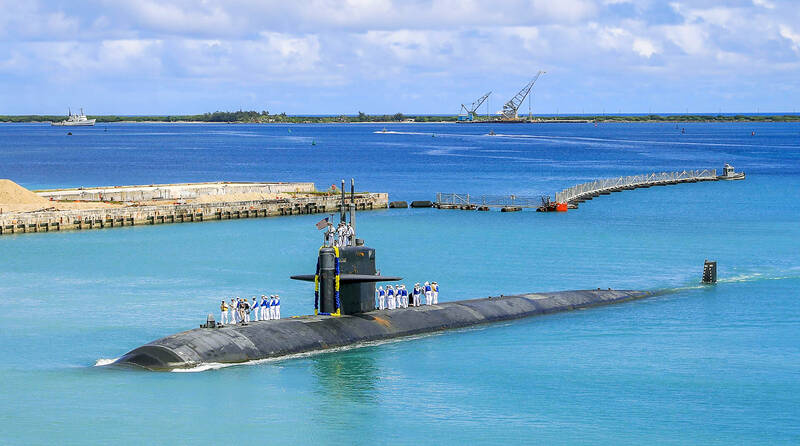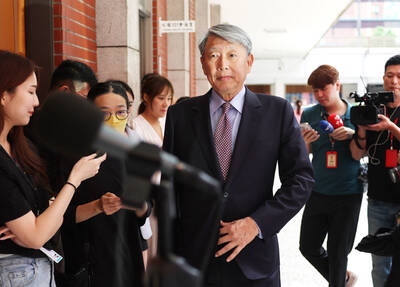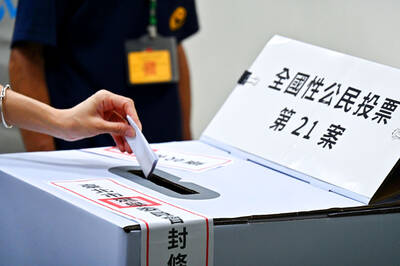An alleged campaign by Chinese state-sponsored hackers on targets in the US and Guam has raised fears that Beijing is preparing to disrupt communications in the Pacific in the event of a conflict.
The hacking campaign was first identified by Microsoft Corp on Wednesday and quickly confirmed by authorities in the US, UK and other allied nations.
Microsoft said the hacking group, which it dubbed Volt Typhoon, had breached government, communications, manufacturing and IT organizations in the US and Guam, a crucial military post in the western Pacific Ocean.

Photo: AP
While the identities of most of the hacking victims remains unknown, US Secretary of the Navy Carlos Del Toro told CNBC on Thursday that the navy was affected by the intrusions.
The extent of the breach was not immediately known, and spokesperson for the navy declined to “discuss the status of our networks.”
Rob Joyce, senior adviser for cybersecurity strategy to the director of the US National Security Agency (NSA), on Thursday told CNN that Chinese hackers could still have access to sensitive US networks that they have targeted.
Joyce said the intrusions stood out in how brazen they were in “scope and scale.”
An NSA representative declined to comment and referred instead to a release by the NSA and other US agencies on the Chinese hacking group.
Microsoft said it had “moderate confidence” that the breaches were carried out in preparation to upend communications in the event of a crisis.
The company’s disclosure came amid mounting concerns that China might take military action against Taiwan.
Former NSA director of operations Jon Darby said the operation matched a well-known method of infiltrating networks by accessing them at the edges, rather than at what he called the bull’s-eye, and then remaining undetected for years.
“The interesting thing is they got in from home routers all the way into the US Navy infrastructure,” said Darby, who is not familiar with the details of this specific case.
“The scary thing is they could then launch disruptive or destructive attacks when things are hitting the fan,” he said. “If they’re in these networks they can wreak havoc. You’ve got to identify and plug up the vulnerabilities that allowed them to get into these networks and eradicate them.”
The NSA, along with intelligence agencies from Australia, Canada, New Zealand and the UK, also shared details on the hackers. The countries are all part of the Five Eyes intelligence alliance.
“We noted this extremely unprofessional report — a patchwork with a broken chain of evidence,” Chinese Ministry of Foreign Affairs spokesperson Mao Ning (毛寧) said. “Apparently, this has been a collective disinformation campaign launched by the US through the Five Eyes to serve its geopolitical agenda.”

CHIPMAKING INVESTMENT: J.W. Kuo told legislators that Department of Investment Review approval would be needed were Washington to seek a TSMC board seat Minister of Economic Affairs J.W. Kuo (郭智輝) yesterday said he received information about a possible US government investment in Taiwan Semiconductor Manufacturing Co (TSMC, 台積電) and an assessment of the possible effect on the firm requires further discussion. If the US were to invest in TSMC, the plan would need to be reviewed by the Department of Investment Review, Kuo told reporters ahead of a hearing of the legislature’s Economics Committee. Kuo’s remarks came after US Secretary of Commerce Howard Lutnick on Tuesday said that the US government is looking into the federal government taking equity stakes in computer chip manufacturers that

NORTHERN STRIKE: Taiwanese military personnel have been training ‘in strategic and tactical battle operations’ in Michigan, a former US diplomat said More than 500 Taiwanese troops participated in this year’s Northern Strike military exercise held at Lake Michigan by the US, a Pentagon-run news outlet reported yesterday. The Michigan National Guard-sponsored drill involved 7,500 military personnel from 36 nations and territories around the world, the Stars and Stripes said. This year’s edition of Northern Strike, which concluded on Sunday, simulated a war in the Indo-Pacific region in a departure from its traditional European focus, it said. The change indicated a greater shift in the US armed forces’ attention to a potential conflict in Asia, it added. Citing a briefing by a Michigan National Guard senior

POWER PLANT POLL: The TPP said the number of ‘yes’ votes showed that the energy policy should be corrected, and the KMT said the result was a win for the people’s voice The government does not rule out advanced nuclear energy generation if it meets the government’s three prerequisites, President William Lai (賴清德) said last night after the number of votes in favor of restarting a nuclear power plant outnumbered the “no” votes in a referendum yesterday. The referendum failed to pass, despite getting more “yes” votes, as the Referendum Act (公民投票法) states that the vote would only pass if the votes in favor account for more than one-fourth of the total number of eligible voters and outnumber the opposing votes. Yesterday’s referendum question was: “Do you agree that the Ma-anshan Nuclear Power Plant

ENHANCED SECURITY: A Japanese report said that the MOU is about the sharing of information on foreign nationals entering Japan from Taiwan in the event of an emergency The Ministry of Foreign Affairs yesterday confirmed that Taiwan and Japan had signed an agreement to promote information exchanges and cooperation on border management, although it did not disclose more details on the pact. Ministry spokesman Hsiao Kuang-wei (蕭光偉) said the ministry is happy to see that the two nations continue to enhance cooperation on immigration control, in particular because Taiwan and Japan “share a deep friendship and frequent people-to-people exchanges.” “Last year, more than 7.32 million visits were made between the two countries, making it even more crucial for both sides to work closer on immigration and border control,” he said. Hsiao